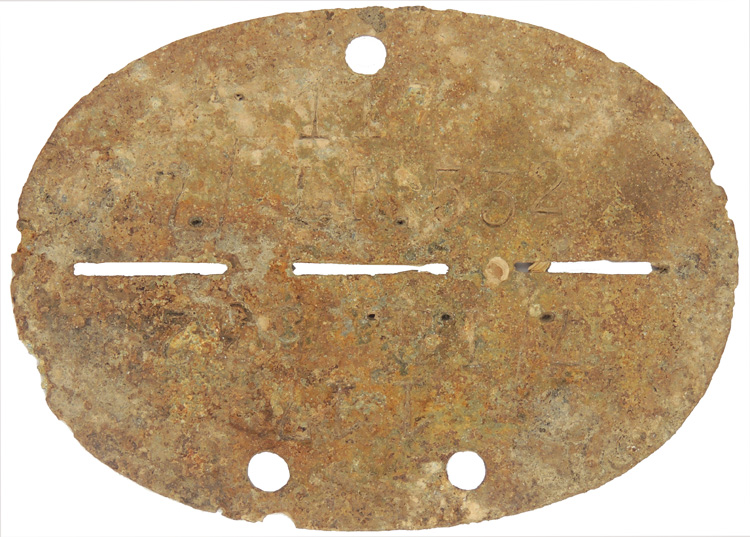



H073685 DOG TAG "7./I.R.532". (Erkennungsmarken)
BACKGROUND: Evaluations of German/Prussian losses in battles during the Austro-Prussian war of 1866 and the Franco-Prussian war of 1870-1871 resulted in the discovery that many of the dead were unidentifiable, which led to the introduction of the first military identification, (dog), tags into the Prussian army in 1878. The original 1878 pattern dog tags remained in usage until a second, larger pattern with more information was introduced in July 1915. In 1918 a slightly modified dog tag was introduced that remain in use until the end of WWII. On mobilization of the Wehrmacht, (Armed Forces), in August 1939 all personnel were issued an identification, (dog), tag to be worn on a cord around the neck. Following the outbreak of WWII all new recruits were issued a dog tag on their registration for military service by their original military unit. If killed or wounded, half of the dog tag would stay attached to the individual and the other half would be sent to the appropriate administrative office for processing. Of Note: Dog tags were issued by the recruitís original military unit, generally a training unit, with a specific, assigned, personal roster number and unit designation and, by regulations, the original dog tag was to remain in use by the recruit, even following unit service transfers, until his final release from military service. The exception to the rule was that lost dog tags would be replaced with a new dog tag bearing a new assigned, personal roster number and the current unit designation by the unit the individual was currently serving with at the time. Originally most dog tags were constructed of aluminum, but later, as the aluminum was required for other, critically, essential items, (Circa late 1941-early 1942), zinc construction tags began to be issued in large quantities with steel dog tags being issued in limited quantities around mid-1944. Field units of the army were required to have spare dog tags on hand to replace lost dog tags as required and generally the field units would be issued spare dog tags that would amount to about 20% of the unitís authorized personnel. Regulations concerning the addition of blood group type stampings on the dog tags appear to not have been instituted until later in the war, (Circa late 1942-early 1943), although blood group markings can be found sporadically on early issued dog tags.
PHYSICAL DESCRIPTION: Roughly 70mm long x 50mm tall, horizontally oval, stamped, natural zinc construction identification tag. The tag has three, roughly 15mm long slits running down the center lengthwise, to facilitate breaking it in half if necessary. The tag has two, punched, holes to the top section and one to the bottom section for securing the neck suspension cord. Marked "7./I.R.532".
GRADE *** PRICE $29.00
To Order this item, please use one of the two e-mail addresses below to contact us. Please make sure to quote the item number in your e-mail
MILITARIA WANTED! If you have items for sale, please contact us. We specialize in selling single pieces and entire collections. Over 3 decades in the business and we do all the work for you. Get the best return for your investment.
-E-Mail Address pawmac@nbnet.nb.ca Or guild@nb.aibn.com
To return to the main page please CLICK below